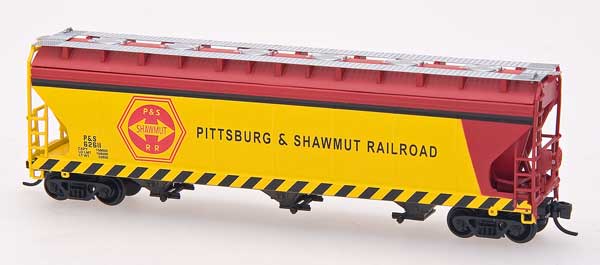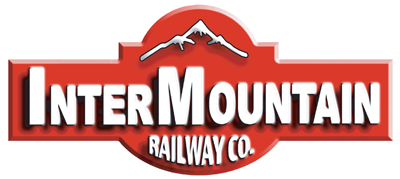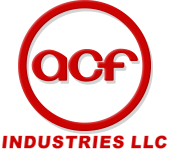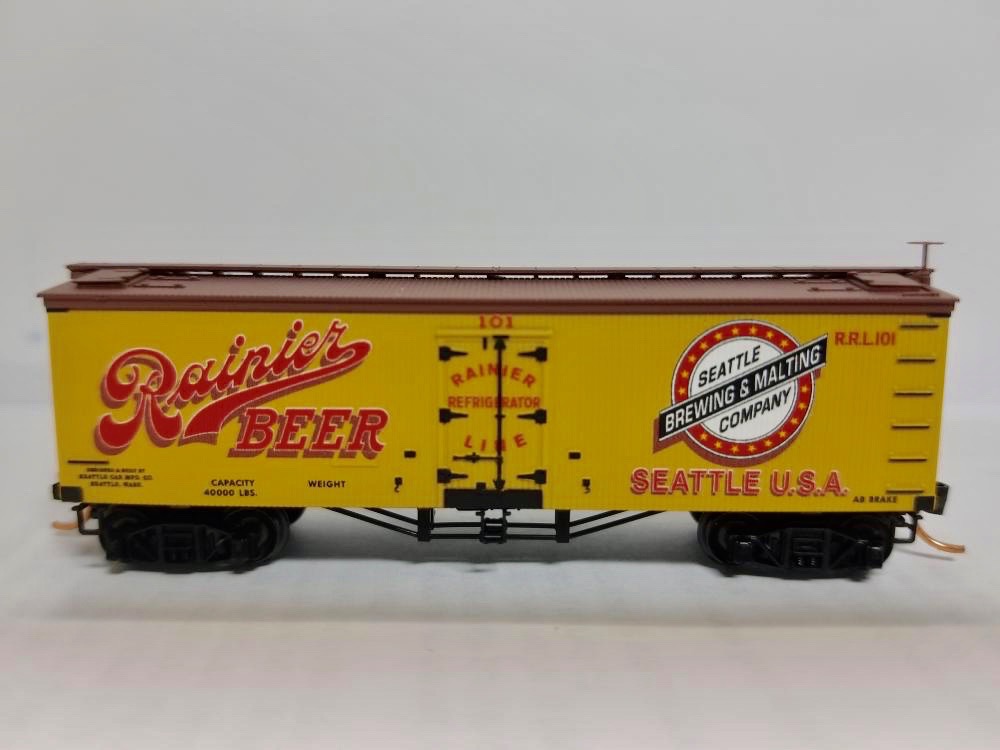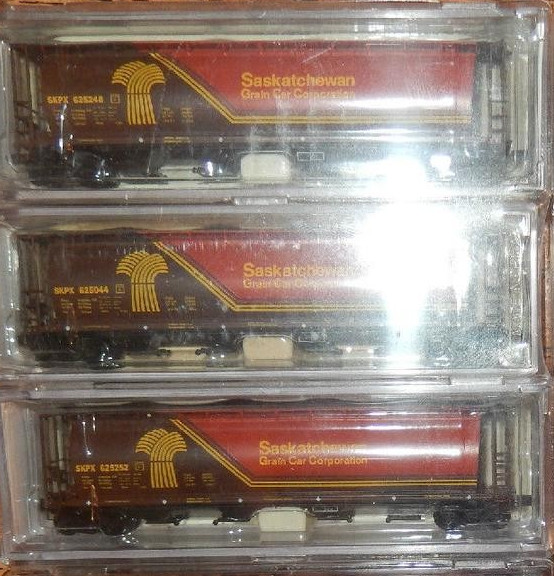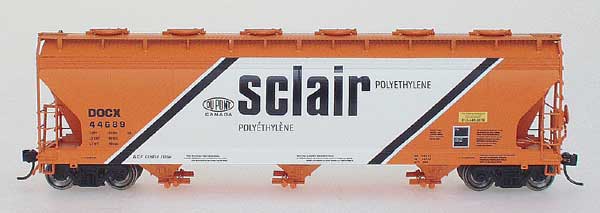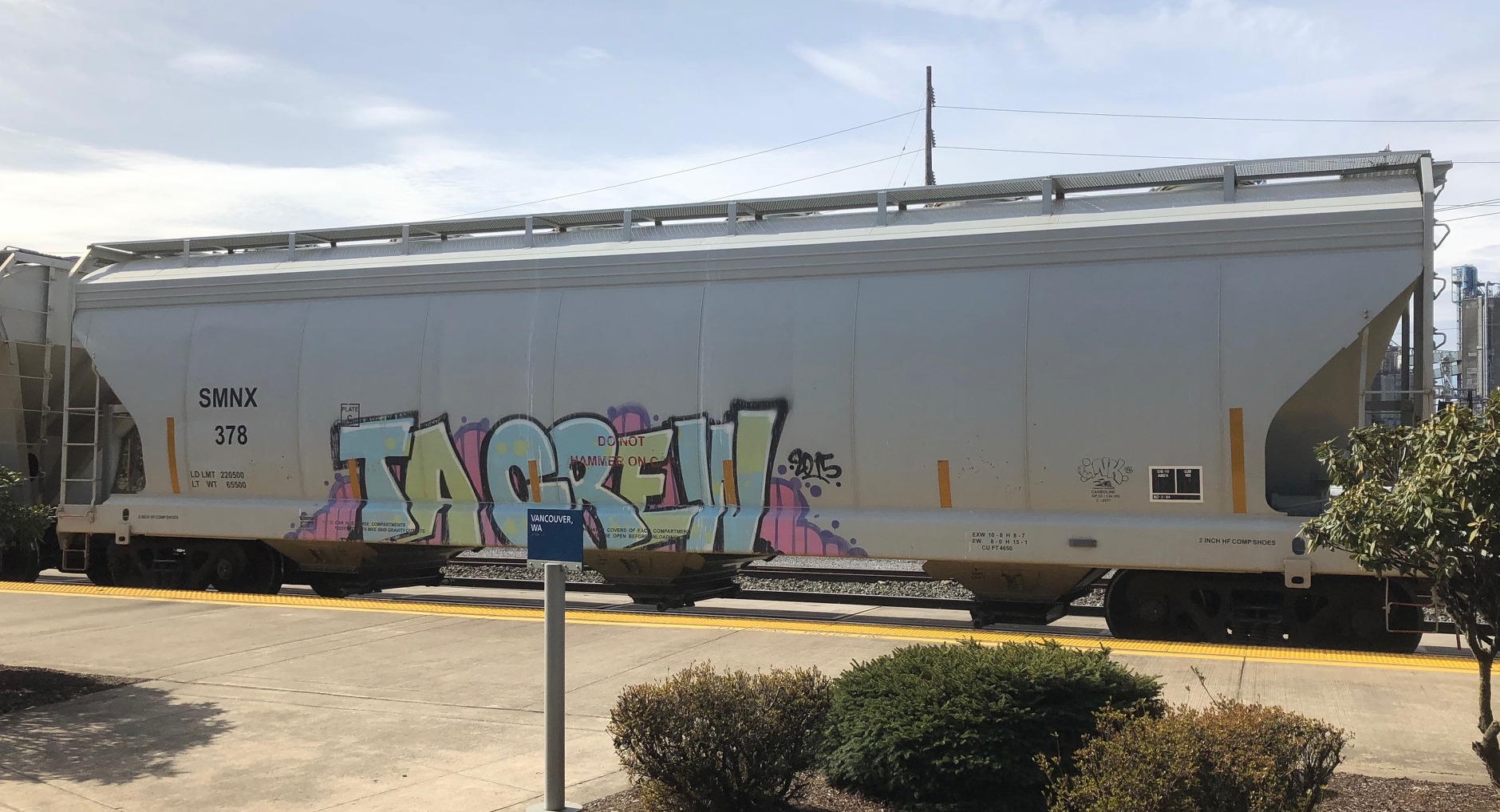Specific Item Information: Only available as part of 3-pack: NSE INT 11-08.
Series Information: "The Way They Should Have Been" is a series of special runs from the NSC (then NSE). The cars in this series are fantasy models of modern cars in paint schemes of defunct companies or historical paint schemes of still existing companies. Road numbers are fictitious as well.
Model Information: This model from InterMountain features Micro-Trains trucks with truck-mounted MTL couplers. Etched metal walkways, sharp printing, and excellent detail including seprately applied hoses on the underframe as well as separately applued roof hatches. Unlike the similar Micro-Trains model, the roof hatches do not open. The InterMountain model has superior detail under the bays, though the MTL model is still quite good. Both have the bay releases as separately applied (as opposed to molded) detail parts. The end detail on the IM model also is superior showing hoses from the barrel (to the brake system?).
Prototype History: Production of the 4650-cubic foot 3-bay cars began in 1964. ACF built 2504 examples at Huntington, WV, between 1964 and 1972. The ACF 4650 c.f. 3-bay hopper was the same height and width as the 5250 c.f. 4-bay car but several feet shorter in length (and only had 3 bays!). Some railroads that were not concerned about having the larger plate C clearance 4650cf cars (which could not be used on all branchlines or at all loading facilities) opted for large fleets of 4650cf cars instead of 4600cf. UP and SP were two such railroads (all of the current UP 4600cf cars came from either MP or C&NW heritage).
Hatches: 6 30", 6 20", 3 pressed steel elongated (SP, SSW, 3 piece pressed steel continuous or 4 piece FRP continuous. Outlets: Several types of bolted or welded on outlets are used. Uses: Grain, soda ash, platic pellets. Trucks: 77 ton friction or roller bearing. 86 had 100 ton roller bearing.
Hatches: 6 30", 6 20", 3 pressed steel elongated (SP, SSW, 3 piece pressed steel continuous or 4 piece FRP continuous. Outlets: Several types of bolted or welded on outlets are used. Uses: Grain, soda ash, platic pellets. Trucks: 77 ton friction or roller bearing. 86 had 100 ton roller bearing.
Road Name History: 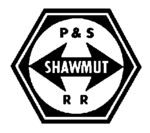 The Pittsburg and Shawmut Railroad (reporting mark PSR), also known as the Shawmut Line, was a short line railroad company operating passenger and freight service on standard gauge track in central and southwestern Pennsylvania. Since 2004, it has been operated as part of the Buffalo and Pittsburgh Railroad, which is owned by Genesee & Wyoming Inc.
The Pittsburg and Shawmut Railroad (reporting mark PSR), also known as the Shawmut Line, was a short line railroad company operating passenger and freight service on standard gauge track in central and southwestern Pennsylvania. Since 2004, it has been operated as part of the Buffalo and Pittsburgh Railroad, which is owned by Genesee & Wyoming Inc.
The Pittsburg and Shawmut Railroad Company began life on July 21, 1903 as the Brookville and Mahoning Railroad, leased by the Pittsburg, Shawmut and Northern Railroad. When the PS&N declared bankruptcy in 1905, the B&M was spun off into a separate entity and was renamed in 1909 due to confusion with the Boston and Maine Railroad's initials. Like its parent, the P&S was also financially troubled in its early years. The company struggled until corporate fortunes improved with the war mobilization of the 1940s. Coal was the principle commodity for the line for its entire existence. Doodlebugs and passenger trains ran on the route in the early years but had all been eliminated by 1939.
The spelling of Pittsburgh as Pittsburg derives from the company's origins in the Pittsburg, Shawmut & Northern Railroad. That company was chartered in 1899 when the official spelling of the name of Pittsburgh, Pennsylvania was without the "h". The city name was spelled Pittsburg from 1891 to 1911 due to an effort by the United States government to standardize the spelling of place names in the United States.

The Pittsburg and Shawmut Railroad Company began life on July 21, 1903 as the Brookville and Mahoning Railroad, leased by the Pittsburg, Shawmut and Northern Railroad. When the PS&N declared bankruptcy in 1905, the B&M was spun off into a separate entity and was renamed in 1909 due to confusion with the Boston and Maine Railroad's initials. Like its parent, the P&S was also financially troubled in its early years. The company struggled until corporate fortunes improved with the war mobilization of the 1940s. Coal was the principle commodity for the line for its entire existence. Doodlebugs and passenger trains ran on the route in the early years but had all been eliminated by 1939.
The spelling of Pittsburgh as Pittsburg derives from the company's origins in the Pittsburg, Shawmut & Northern Railroad. That company was chartered in 1899 when the official spelling of the name of Pittsburgh, Pennsylvania was without the "h". The city name was spelled Pittsburg from 1891 to 1911 due to an effort by the United States government to standardize the spelling of place names in the United States.
Brand/Importer Information: InterMountain was founded in 1985 by Fred Brummet. They got started in the model railroad business by producing O-Scale model kits. They got started in the N Scale business almost a decade later when in 1994 they introduced the 40-23 reefer car in kit form. Later, in 1998, they started producing RTR (Ready-to-Run) models. By the early 2000s, InterMountain phased out kit production in favor of the RTR models.
The InterMountain Railway company is located at 1224 Boston Ave in Longmont, CO. They are a manufacturer of HO, N and Z scale model trains. They have produced kits as well as RTR (Ready-To-Run) models. Their N Scale products include locomotives as well as rolling stock. Their rolling stock lineup includes Boxcars, Hoppers, Tank Cars, Reefers, Gondolas, Stock Cars and Flatcars.
Their locomotive releases have primarily been diesel units, with the one major exception being their series of AC-12 Cab Forward steam locos. Their diesel lineup includes F3's, F7's, F9's, SD40's, SD45's and FT units. They are known for quality and detail. They also release their rolling stock in larger varieties of road numbers than most of the other manufacturers.
The InterMountain Railway company is located at 1224 Boston Ave in Longmont, CO. They are a manufacturer of HO, N and Z scale model trains. They have produced kits as well as RTR (Ready-To-Run) models. Their N Scale products include locomotives as well as rolling stock. Their rolling stock lineup includes Boxcars, Hoppers, Tank Cars, Reefers, Gondolas, Stock Cars and Flatcars.
Their locomotive releases have primarily been diesel units, with the one major exception being their series of AC-12 Cab Forward steam locos. Their diesel lineup includes F3's, F7's, F9's, SD40's, SD45's and FT units. They are known for quality and detail. They also release their rolling stock in larger varieties of road numbers than most of the other manufacturers.
Commissioner Information:  The N Scale Enthusiast Society (previously known as The N Scale Collector until 2011) was established by Wick Brandon, as a sole proprietorship and was a stand alone company until Wick passed away in 2000. The company has been owned by Micro Trains Line since then.
The N Scale Enthusiast Society (previously known as The N Scale Collector until 2011) was established by Wick Brandon, as a sole proprietorship and was a stand alone company until Wick passed away in 2000. The company has been owned by Micro Trains Line since then.
Wick was the founder of TexNRails and he established NSE right after he sold the pioneering N Scale retailer to the Herz family, and the store moved to Florida. Wick and Lea moved their family from Texas to Bakersfield California, and the entire operation was run from his home in Bakersfield. George Johnsen, the current Chairman, came on board as Associate Editor starting with the third issue of the magazine, and the growth of the organization hasn’t stopped. Wick and George did the first convention in Medford in 1993, and added staff and advisors as the organization grew. Wick held the first auction for the NSE in 1995.
The NSE mission statement reads: “This organization is dedicated to the preservation of the history of N Scale Model Railroading, and the railroads they represent.”
They do:
- Special Run Cars
- Regular Auctions of "collectable" Cars
- Annual Conventions
- Bi-Monthly Magazine
Wick was the founder of TexNRails and he established NSE right after he sold the pioneering N Scale retailer to the Herz family, and the store moved to Florida. Wick and Lea moved their family from Texas to Bakersfield California, and the entire operation was run from his home in Bakersfield. George Johnsen, the current Chairman, came on board as Associate Editor starting with the third issue of the magazine, and the growth of the organization hasn’t stopped. Wick and George did the first convention in Medford in 1993, and added staff and advisors as the organization grew. Wick held the first auction for the NSE in 1995.
The NSE mission statement reads: “This organization is dedicated to the preservation of the history of N Scale Model Railroading, and the railroads they represent.”
They do:
- Special Run Cars
- Regular Auctions of "collectable" Cars
- Annual Conventions
- Bi-Monthly Magazine
Item created by: gdm on 2018-03-06 14:36:26
Last edited by: Alain LM on 2021-06-20 04:36:12
If you see errors or missing data in this entry, please feel free to log in and edit it. Anyone with a Gmail account can log in instantly.
Last edited by: Alain LM on 2021-06-20 04:36:12
If you see errors or missing data in this entry, please feel free to log in and edit it. Anyone with a Gmail account can log in instantly.


